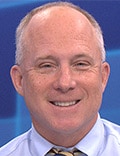As experimental drugs to treat non-alcoholic steatohepatitis (NASH) continue to dash themselves on the shoals of the federal regulatory system, clinicians should know that at least one effective therapy exists.

Dr Jay Shubrook
“Weight loss is the treatment; you negotiate with your patients the method,’ said Jay Shubrook, DO, who specializes in metabolic disorders at Touro University California College of Osteopathic Medicine in Vallejo. The terms of that negotiation are flexible, to a degree: eating more whole and fewer processed foods, exercising more, employing a GLP-1 agonist, or advising bariatric surgery for appropriate patients. Surgery might be especially valuable in adolescents, Shubrook added, because their longer remaining lifespans give them more years to enjoy its benefits.
Shubrook, co-author of a review this month in the journal Diabetes, Obesity and Metabolism focused on primary care strategies for treating non-alcoholic fatty liver disease (NAFLD) or NASH, said losing at least 5% of body weight would be beneficial for reducing the effects of diabetes and obesity. A 10% reduction reduces the chance of progression from NAFLD to NASH or from NASH to early fibrosis.
Many people with signs of NAFLD do not progress to advanced liver fibrosis. In many cases, the same treatment strategies used for managing diabetes and obesity should neutralize the risks of NAFLD, too. Ideally, these strategies would prevent NAFLD from progressing to NASH, which is more severe and may result in cirrhosis or needing a liver transplant.
“Most people with NAFLD and NASH still die of cardiovascular disease. The second most common complication is non-liver cancer. The third is liver cirrhosis and hepatic carcinoma,’ Shubrook said.
A Growing Epidemic
Perhaps as many as 35% of Americans and 30% of people worldwide have NAFLD, according to a 2019 estimate. Roughly 20% of this group is at risk for developing NASH. Type 2 diabetes, obesity, and NAFLD are tightly linked, with research suggesting that half of adults with type 2 diabetes also have NAFLD. NAFLD or NASH have traditionally been diagnosed by liver biopsy, and still can be, but biopsies are inherently invasive. The non-invasive liver ultrasound FibroScan can detect risk for worsening fibrosis. The FDA has yet to approve treatments targeted to NAFLD and NASH, although several companies have been working on such drugs.
Role of the PCP
“Just like diabetes, NAFLD is a silent disease that is progressing,’ said Shubrook, who is also a co-author of a 2021 clinical care pathway for treating NAFLD and NASH.
He recommended using the FIB-4 assessment — an easy calculation that comprises age, levels of the liver enzymes aspartate transaminase and alanine aminotransferase, and platelet counts — to determine patients most at risk for NASH and eventually cirrhosis. The lowest FIB-4 score indicates the lowest risk for developing advanced fibrosis; medium values suggest intermediate or indeterminate risk; and the highest FIB-4 score predicts the worst outcomes.
Patients who fall in the intermediate/indeterminate group could take additional blood tests, or have an ultrasound of their liver, to determine if they are at high or low risk for developing advanced fibrosis.
Patients in the highest-risk group should be referred immediately to a hepatologist, Shubrook said. A liver specialist may order a biopsy and likely will work with patients to sustain long-term weight loss — either through lifestyle changes, use of a GLP-1 agonist such as semaglutide or tirzepatide (Mounjaro), or through bariatric surgery. A May 2023 Lancet study showed that bariatric surgery can reduce the severity of NASH.
Those in the lowest risk groups should also be counseled on how to reduce weight. But unless their liver shows signs of worsening, people in this group would always remain in the care of a primary care clinician and not a hepatologist.
“Our goal is to identify people most at risk of progression to cirrhosis, and then to prevent it. That doesn’t have to be a liver-directed therapy, necessarily,’ said Nancy S. Reau, MD, a hepatologist at Rush Medical College in Chicago. Liver troubles are to some extent a reflection of excess weight and stress to the cardiovascular system.

Dr Nancy Reau
“If 40% of America has fatty liver disease, 40% of America can’t go to liver clinic,’ added Reau, who relies on referrals for possible NAFLD from primary care clinicians given a comparative dearth of hepatologists. Sometimes a referral might be premature, and Reau will send a patient back to their physician with instructions to regularly calculate the FIB-4 level and send their patient back again as soon as that score becomes concerning.
Sometimes those referrals come too late.
“For years patients have said their primary care doctor will say, ‘Oh, you just have a little fatty liver,’ and then years later they have cirrhosis or are on a transplant list,’ said Donna Cryer, JD, CEO of the Global Liver Institute in Washington, DC. Cryer, a liver transplant recipient, is a co-author with Shubrook of this month’s review article on NASH and NAFLD.
A patient’s electronic medical record system may calculate the FIB-4 score automatically, Cryer noted, making stratification of NAFLD risk levels easy. Sometimes physicians say they do not want to screen for NAFLD or NASH until FDA approved treatments exist, Cryer said. But this reluctance runs the risk of not catching the disease until it has progressed to obvious symptoms.
And clinicians should always pay attention to how they communicate with patients, regardless of the severity of their case, Cryer advised:
“The best places give more structured advice and support about what type of lifestyle modification you would need based on the severity of your liver disease. It’s not just, ‘You should eat less and exercise.’ Well, shouldn’t we all?”
Shubrook also stressed the importance of good patient communication, noting that the plethora of options for lowering weight and consequently protecting the liver makes this conversation easier.
“Because we have multiple choices, it’s really easy to have a shared decision approach with your patients,’ he said. “In chronic disease management you’ve got to have buy-in.’
Shubrook reports relationships with Abbott, Bayer, Novo Nordisk, AstraZeneca, Eli Lilly, and Nevro. Reau reports relationships with AbbVie, Gilead, Arbutus, Intercept, and Salix. Cryer reports no relevant financial relationships.
Marcus A. Banks, MA, is a journalist based in New York City who covers health news with a focus on new cancer research. His work appears in Medscape, Cancer Today, The Scientist, Gastroenterology & Endoscopy News, Slate, TCTMD, and Spectrum.
For more news, follow Medscape on Facebook, Twitter, Instagram, YouTube, and LinkedIn
Source: Read Full Article